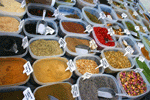quinta-feira, novembro 23, 2006
How are plant products used in Ayurvedic treatment?

In Ayurveda, the distinction between food and medicine is not as clear as in Western medicine.
Food and diet are important components of Ayurvedic practice, and so there is a heavy reliance on treatments based on herbs and plants, oils (such as sesame oil), common spices (such as turmeric), and other naturally occurring substances.
Currently, some 5,000 products are included in the "pharmacy" of Ayurvedic treatments.
In recent years, the Indian government has collected and published safety information on a small number of them.
Historically, plant compounds have been grouped into categories according to their effects. For example, some compounds are thought to heal, promote vitality, or relieve pain. The compounds are described in many texts prepared through national medical agencies in India.
Below are a few examples of how some botanicals (plants and their products) have been or are currently used in treatment. In some cases, these may be mixed with metals.
The spice turmeric has been used for various diseases and conditions, including rheumatoid arthritis, Alzheimer's disease, and wound healing.
A mixture (Arogyawardhini) of sulfur, iron, powdered dried fruits, tree root, and other substances has been used to treat problems of the liver.
An extract from the resin from a tropical shrub (Commiphora mukul, or guggul) has been used for a variety of illnesses. In recent years, there has been research interest in its use to possibly lower cholesterol.


